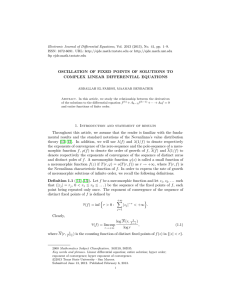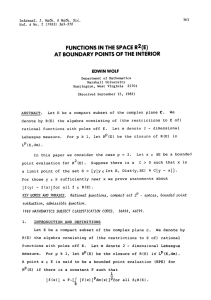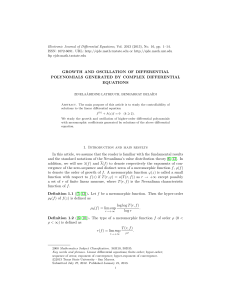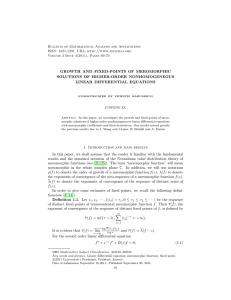Document 10677443
advertisement
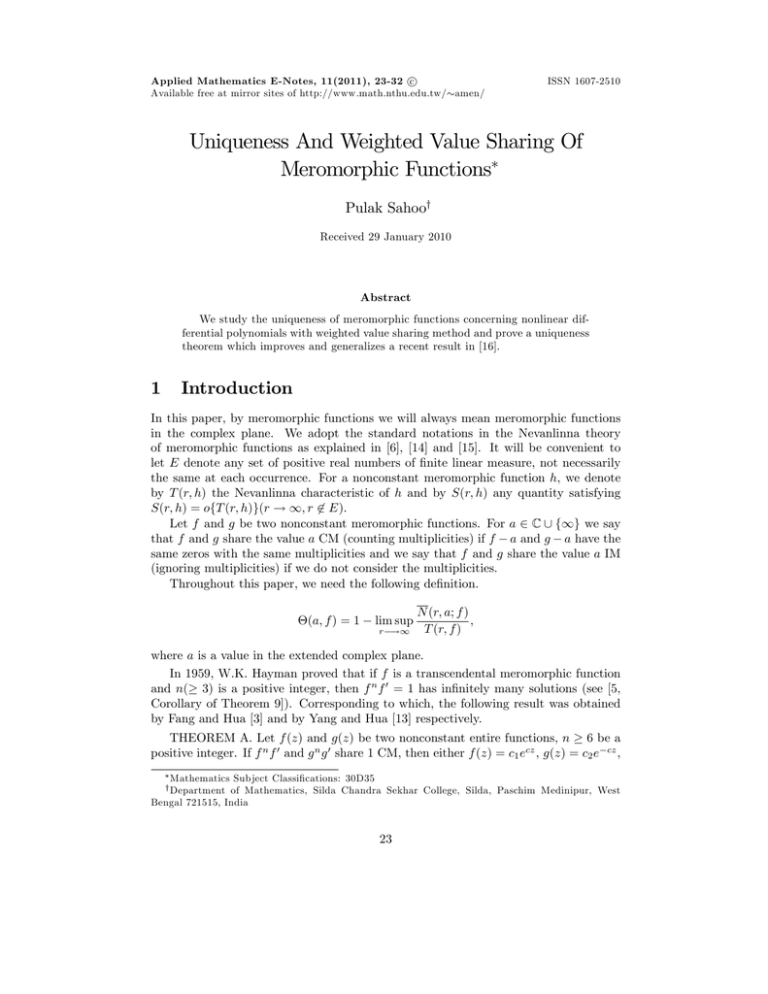
Applied Mathematics E-Notes, 11(2011), 23-32 c Available free at mirror sites of http://www.math.nthu.edu.tw/ amen/ ISSN 1607-2510 Uniqueness And Weighted Value Sharing Of Meromorphic Functions Pulak Sahooy Received 29 January 2010 Abstract We study the uniqueness of meromorphic functions concerning nonlinear differential polynomials with weighted value sharing method and prove a uniqueness theorem which improves and generalizes a recent result in [16]. 1 Introduction In this paper, by meromorphic functions we will always mean meromorphic functions in the complex plane. We adopt the standard notations in the Nevanlinna theory of meromorphic functions as explained in [6], [14] and [15]. It will be convenient to let E denote any set of positive real numbers of …nite linear measure, not necessarily the same at each occurrence. For a nonconstant meromorphic function h, we denote by T (r; h) the Nevanlinna characteristic of h and by S(r; h) any quantity satisfying S(r; h) = ofT (r; h)g(r ! 1; r 62 E): Let f and g be two nonconstant meromorphic functions. For a 2 C [ f1g we say that f and g share the value a CM (counting multiplicities) if f a and g a have the same zeros with the same multiplicities and we say that f and g share the value a IM (ignoring multiplicities) if we do not consider the multiplicities. Throughout this paper, we need the following de…nition. (a; f ) = 1 lim sup r !1 N (r; a; f ) ; T (r; f ) where a is a value in the extended complex plane. In 1959, W.K. Hayman proved that if f is a transcendental meromorphic function and n( 3) is a positive integer, then f n f 0 = 1 has in…nitely many solutions (see [5, Corollary of Theorem 9]). Corresponding to which, the following result was obtained by Fang and Hua [3] and by Yang and Hua [13] respectively. THEOREM A. Let f (z) and g(z) be two nonconstant entire functions, n 6 be a positive integer. If f n f 0 and g n g 0 share 1 CM, then either f (z) = c1 ecz , g(z) = c2 e cz , Mathematics Subject Classi…cations: 30D35 of Mathematics, Silda Chandra Sekhar College, Silda, Paschim Medinipur, West Bengal 721515, India y Department 23 24 Uniqueness and Weighted Value Sharing of Meromorphic Functions where c1 , c2 and c are three constants satisfying (c1 c2 )n+1 c2 = 1 or f (z) tg(z) for a constant t such that tn+1 = 1. Fang [4] considered about the k-th derivative instead of the …rst derivative and proved the following theorems. THEOREM B. Let f (z) and g(z) be two nonconstant entire functions, and let n; k be two positive integers with n > 2k + 4. If [f n ](k) and [g n ](k) share 1 CM, then either f (z) = c1 ecz , g(z) = c2 e cz , where c1 , c2 and c are three constants satisfying ( 1)k (c1 c2 )n (nc)2k = 1 or f (z) tg(z) for a constant t such that tn = 1. THEOREM C. Let f (z) and g(z) be two nonconstant entire functions, and let n; k be two positive integers with n 2k + 8. If [f n (f 1)](k) and [g n (g 1)](k) share 1 CM, then f (z) g(z). Recently Bhoosnurmath and Dyavanal [2] also considered the uniqueness of meromorphic functions corresponding to the k-th derivative of a linear polynomial expression. They proved the following theorem. THEOREM D. Let f (z) and g(z) be two nonconstant meromorphic functions, and let n; k be two positive integers with n > 3k + 8. If [f n (z)](k) and [g n (z)](k) share 1 CM, then either f (z) = c1 ecz , g(z) = c2 e cz , where c1 , c2 and c are three constants satisfying ( 1)k (c1 c2 )n (nc)2k = 1 or f (z) tg(z) for a constant t such that tn = 1. Naturally, one may ask the following question: Is it possible in any way to relax the nature of sharing the value 1 in the above results? It is worth mentioning that in the above area some investigations has already been carried out by Zhang and Lu [16]. To state the result we require the following de…nition known as weighted sharing of values introduced by Lahiri [8, 9] which measure how close a shared value is to being shared CM or to being shared IM. DEFINITION 1. Let k be a nonnegative integer or in…nity. For a 2 C [ f1g we denote by Ek (a; f ) the set of all a-points of f where an a-point of multiplicity m is counted m times if m k and k + 1 times if m > k. If Ek (a; f ) = Ek (a; g), we say that f , g share the value a with weight k. The de…nition implies that if f , g share a value a with weight k, then z0 is an apoint of f with multiplicity m( k) if and only if it is an a-point of g with multiplicity m( k) and z0 is an a-point of f with multiplicity m(> k) if and only if it is an a-point of g with multiplicity n(> k), where m is not necessarily equal to n. We write f , g share (a; k) to mean that f , g share the value a with weight k. Clearly if f , g share (a; k) then f , g share (a; p) for any integer p, 0 p < k. Also we note that f , g share a value a IM or CM if and only if f , g share (a; 0) and (a; 1) respectively. Zhang and Lu [16] proved the following theorem. THEOREM E. Let f (z) and g(z) be two nonconstant transcendental meromorphic functions, and let n( 1), k( 1), l( 0) be three integers. Suppose that [f n ](k) and [g n ](k) share (1; l), if l 2 and n > 3k + 8 or if l = 1 and n > 5k + 11 or if l = 0 and n > 9k + 14, then either f (z) = c1 ecz , g(z) = c2 e cz , where c1 , c2 and c are three constants satisfying ( 1)k (c1 c2 )n (nc)2k = 1 or f (z) tg(z) for a constant t such that tn = 1. Regarding Theorem E, it is natural to ask the following questions. P. Sahoo 25 QUESTION 1. What can be said about the relation between two nonconstant meromorphic functions f and g, if ff n (f m a)g(k) and fg n (g m a)g(k) share (b; l) for a nonzero constant b? QUESTION 2. What can be said about the relation between two nonconstant meromorphic functions f and g, if ff n (f 1)m g(k) and fg n (g 1)m g(k) share (b; l) for a nonzero constant b? Recently Liu [11] proved the following theorem relating with Question 1. THEOREM F. Let f (z) and g(z) be two nonconstant meromorphic functions, and let n, m and k be three positive integers, and , be two constants such that j j+j j = 6 0. If [f n ( f m + )](k) and [g n ( g m + )](k) share (1; l), and one of the following conditions holds: (a) l 2 and n > 3m + 3k + 8; (b) l = 1 and n > 4m + 5k + 10; (c) l = 0 and n > 6m + 9k + 14: Then 3 , then f (z) g(z); if m = 1 and (i) when 6= 0, if m 2 and (1; f ) > m+n 3 (1; f ) > n+1 , then f (z) g(z); and (ii) when = 0, if f (z) 6= 1 and g(z) 6= 1, then either f (z) tg(z), where t is a constant satisfying tn+m = 1, or f (z) = c1 ecz , g(z) = c2 e cz , where c1 , c2 and c are three constants satisfying ( 1)k 2 (c1 c2 )n+m [(n + m )c]2k = 1 or ( 1)k 2 (c1 c2 )n+m [(n + m )c]2k = 1, where m = m, = 0 if 1 if =0 6= 0. In this paper, we will prove the following theorem which not only provide a supplementary result of Theorem D, also improve and generalize Theorem E. Moreover, our theorem deal with Question 2 also. THEOREM 1. Let f (z) and g(z) be two transcendental meromorphic functions, and let n( 1), k( 1), m( 0) and l( 0) be four integers. Let [f n (f 1)m ](k) and [g n (g 1)m ](k) share (b; l) for a nonzero constant b. Then (i) when m = 0, if f (z) 6= 1, g(z) 6= 1 and l 2, n > 3k + 8 or l = 1, n > 5k + 10 or l = 0, n > 9k + 14, then either f (z) = c1 ecz , g(z) = c2 e cz , where c1 , c2 and c are three constants satisfying ( 1)k (c1 c2 )n (nc)2k = b2 or f (z) tg(z) for a constant t such that tn = 1; (ii) when m = 1 and (1; f ) > n2 , then either [f n (f 1)m ](k) [g n (g 1)m ](k) b2 or f (z) g(z) provided one of l 2, n > 3k + 11 or l = 1, n > 5k + 14 or l = 0, n > 9k + 20 holds; and (iii) when m 2 and l 2, n > 3k + m + 10 or l = 1, n > 5k + 2m + 12 or l = 0, n > 9k + 4m + 16, then either [f n (f 1)m ](k) [g n (g 1)m ](k) b2 or f (z) g(z) or f (z) and g(z) satisfy the algebraic equation R(f; g) = 0, where R(x; y) = xn (x 1)m y n (y 1)m : REMARK 1. The possibility [f n (f 1)m ](k) [g n (g 1)m ](k) b2 of Theorem 1 does not arise for k = 1. REMARK 2. Obviously Theorem 1 is an improvement of Theorem E for m = 0 and l = 1. 26 Uniqueness and Weighted Value Sharing of Meromorphic Functions Though the standard de…nitions and notations of the value distribution theory are available in [6], we explain some de…nitions and notations which are used in the paper. DEFINITION 2. [7] Let p be a positive integer and b 2 C [ f1g: Then by N (r; b; f j p) we denote the counting function of those b-points of f (counted with multiplicities) whose multiplicities are not greater than p. By N (r; b; f j p) we denote the corresponding reduced counting function. In an analogous manner we de…ne N (r; b; f j p) and N (r; b; f j p). DEFINITION 3. [10] Let k be a positive integer or in…nity. We denote by Nk (r; b; f ) the counting function of b-points of f , where an b-point of multiplicity m is counted m times if m k and k times if m > k. That is Nk (r; b; f ) = N (r; b; f ) + N (r; b; f j 2) + ::: + N (r; b; f j k): DEFINITION 4. For b 2 C [ f1g we put k (b; f ) =1 lim sup r!1 2 Nk (r; b; f ) : T (r; f ) Lemmas In this section we present some lemmas which will be needed to prove the theorems. LEMMA 1. [12] Let f (z) be a nonconstant meromorphic function and P (f ) = a0 + a1 f + a2 f 2 + ::: + an f n , where a0 , a1 , a2 , ... ,an are constants and an 6= 0. Then T (r; P (f )) = nT (r; f ) + S(r; f ): LEMMA 2. [11] Let f (z) and g(z) be two nonconstant meromorphic functions, k( 1), l( 0) be integers. Suppose that f (k) and g (k) share (1; l). If one of the following conditions holds, then either f (k) (z)g (k) (z) 1 or f (z) g(z). (i) l 2 and 1 = 2 (1; f ) + (k + 2) (1; g) + (0; f ) + (0; g) + k+1 (0; f ) + k+1 (0; g) > k + 7; (ii) l = 1 and 2 = (k+3) (1; f )+(k+2) (1; g)+ (0; f )+ (0; g)+2 k+1 (0; f )+ k+1 (0; g) > 2k + 9; (iii) l = 0 and 3 = (2k + 4) (1; f ) + (2k + 3) (1; g) + (0; f ) + (0; g) + 3 k+1 (0; f ) + 2 k+1 (0; g) > 4k + 13: m( LEMMA 3. Let f and g be two nonconstant meromorphic functions and n( 1), k( 1) be three integers. Then [f n (f for k = 1 and n 1)m ](k) [g n (g 1)m ](k) 6 b2 ; 1)m ](k) [g n (g 1)m ](k) b2 ; m + 3. PROOF. If possible, let [f n (f 1), P. Sahoo 27 for k = 1. That is, fn 1 (f 1)m 1 d)f 0 g n (cf 1 1)m (g 1 (cg d)g 0 b2 ; where c = n + m and d = n. Let z0 be a 1-point of f with multiplicity p( pole of g with multiplicity q( 1) such that mp 1), and a 1 = (n + m)q + 1; i.e., mp = (n + m)q + 2 n + m + 2; i.e., n+m+2 : m d with multiplicity p1 ( 1), and a pole of g with multiplicity p Let z1 be a zero of cf q1 ( 1) such that 2p1 1 = (n + m)q1 + 1; i.e., n+m+2 : 2 Let z2 be a zero of f with multiplicity p2 ( 1); and a pole of g with multiplicity q2 ( 1). Then np2 1 = (n + m)q2 + 1: (1) p1 From (1) we get mq2 + 2 = n(p2 q2 ) n; i.e., q2 n 2 m : Thus from (1) we get (n + m)(n m np2 = (n + m)q2 + 2 2) + 2; i.e., n+m 2 : m Since a pole of f is either a zero of g(g 1)(cg d) or a zero of g 0 , we have p2 N (r; 1; f ) N (r; 0; g) + N (r; 1; g) + N m+2 m + n+m+2 n+m 2 d r; ; g + N 0 (r; 0; g 0 ) + S(r; f ) + S(r; g) c T (r; g) + N 0 (r; 0; g 0 ) + S(r; f ) + S(r; g); where N 0 (r; 0; g 0 ) denotes the reduced counting function of those zeros of g 0 which are not the zeros of g(g 1)(cg d). 28 Uniqueness and Weighted Value Sharing of Meromorphic Functions Then by the second fundamental theorem of Nevanlinna we get d r; ; f c N (r; 0; f ) + N (r; 1; f ) + N 2T (r; f ) m+2 m + n+m+2 n+m + N (r; 1; f ) fT (r; f ) + T (r; g)g 2 N 0 (r; 0; f 0 ) + S(r; f ) N 0 (r; 0; f 0 ) + N 0 (r; 0; g 0 ) + S(r; f ) + S(r; g): (2) Similarly we get m+2 m + n+m+2 n+m 2T (r; g) 2 fT (r; f ) + T (r; g)g + N 0 (r; 0; f 0 ) N 0 (r; 0; g 0 ) + S(r; f ) + S(r; g): (3) Adding (2) and (3) we obtain m+2 n+m+2 1 m n+m 2 fT (r; f ) + T (r; g)g S(r; f ) + S(r; g); which is a contradiction for n m + 3. This proves the lemma. LEMMA 4. [1] Let f , g be two nonconstant meromorphic functions and let, k 1 and n > 3k + 8 be two integers. If [f n ](k) [g n ](k) b2 , where b(6= 0), be a constant, cz cz then f (z) = c1 e , g(z) = c2 e , where c1 , c2 and c are three constants satisfying ( 1)k (c1 c2 )n (nc)2k = b2 . 3 Proof of Theorem 1 We consider F (z) = (1; F ) = f n (f 1)m b 1 1 and G(z) = g n (g 1)m . b N (r; 1; F ) lim sup =1 T (r; F ) r !1 T (r; f ) lim sup r !1 (m + n)T (r; f ) Using Lemma 1, we get lim sup N r; 1; f n 1)m (f b (m + n)T (r; f ) r !1 n+m 1 : m+n (4) Similarly (1; G) n+m 1 : m+n (5) n (0; F ) = 1 1 m N r; 0; f (f b 1) N (r; 0; F ) lim sup = 1 lim sup T (r; F ) (m + n)T (r; f ) r !1 r !1 (1 + m )T (r; f ) n+m 1 m lim sup ; m+n r !1 (m + n)T (r; f ) where m = 0 if m = 0 1 if m 1. (6) P. Sahoo 29 Similarly (0; G) n+m 1 m : n+m (7) n k+1 (0; F ) = Nk+1 r; 0; f (f b 1) Nk+1 (r; 0; F ) lim sup = 1 lim sup T (r; F ) (m + n)T (r; f ) r !1 r !1 (k + m + 1)T (r; f ) n k 1 lim sup : (m + n)T (r; f ) m+n r !1 1 1 m (8) Similarly k+1 (0; G) n k 1 : m+n (9) Since F (k) and G(k) share (1; l), we discuss the following three cases: Case 1. Let l 2. From (4)-(9) we obtain 1 n+m 1 m n k 1 n+m 1 +2 +2 m+n m+n m+n = (k + 4) = 1 [(k + 4)(n + m m+n It is easily veri…ed that 1) + 2(n + m 1 m ) + 2(n k 1)] : > k + 7 provided n > 3k + m + 2m + 8: Since 8 if m = 0 < 3k + 8 3k + 11 if m = 1 3k + m + 2m + 8 = : 3k + m + 10 if m 2, 1 by (i) of Lemma 2 we obtain either F (k) G(k) 1 or F Case 2. Let l = 1. Then from (4)-(9) we obtain 2 G. n+m 1 n+m 1 m n k 1 +2 +3 m+n m+n m+n = (2k + 5) = 1 [(2k + 5)(n + m m+n It is easily veri…ed that 1) + 2(n + m 1 m ) + 3(n k 1)] : > 2k + 9 provided n > 5k + 2m + 2m + 10: Since 8 if m = 0 < 5k + 10 5k + 14 if m = 1 5k + 2m + 2m + 10 = : 5k + 2m + 12 if m 2, 2 by (ii) of Lemma 2 we obtain either F (k) G(k) 1 or F G. Case 3. Let l = 0. Then as Case 1 and Case 2, it is easy to verify that when n > 9k + 4m + 2m + 14: Since 8 if m = 0 < 9k + 14 9k + 20 if m = 1 9k + 4m + 2m + 14 = : 9k + 4m + 16 if m 2, 3 > 4k + 13 30 Uniqueness and Weighted Value Sharing of Meromorphic Functions by (iii) of Lemma 2 we obtain either F (k) G(k) We suppose that F (k) G(k) 1. That is [f n (f 1)m ](k) [g n (g 1 or F G. 1)m ](k) b2 : (10) Let m = 0. Since f (z) 6= 1 and g(z) 6= 1, by (10) and Lemma 4 we obtain f (z) = c1 ecz , g(z) = c2 e cz , where c1 , c2 and c are three constants satisfying ( 1)k (c1 c2 )n (nc)2k = b2 . Again by Lemma 3, [f n (f for k = 1 and m 1)m ](k) [g n (g 1)m ](k) 6 b2 ; 1. Next we suppose that F G: i.e., f n (f 1)m g n (g 1)m : Now we consider the following three subcases. Subcase (i). Let m = 0. Then from (11) we get f tn = 1. Subcase (ii). Let m = 1. Then from (11) we obtain f n (f Suppose f 6 g. Let h = hn 6= 1, hn+1 6= 1 and g = is not a constant. Since f 6 f= 1 hn 1 hn+1 f g 1) g n (g (11) tg for a constant t such that 1): (12) be a constant. Then from (12) it follows that h 6= 1, constant, a contradiction. So we suppose that h n g, we have h 6 1. From (12) we obtain g = 11 hhn+1 and 1 hn 1 hn+1 = h. Hence it follows that T (r; f ) = nT (r; h) + S(r; f ): Again by second fundamental theorem of Nevanlinna, we have N (r; 1; f ) = where obtain j n X N (r; j ; h) (n 2)T (r; h) + S(r; f ); j=1 (6= 1) (j = 1; 2; :::; n) are distinct roots of the equation hn+1 = 1. So we (1; f ) = 1 lim sup r !1 N (r; 1; f ) T (r; f ) which contradicts the assumption (1; f ) > n2 : Thus f Subcase (iii). Let m 2: Then from (11) we obtain f n [f m + +( 1)i m 2 ; n g: Cm i f m i + +( 1)m ] = g n [g m + +( 1)i m Cm i g m i + +( 1)m ]: (13) P. Sahoo 31 Let h = fg . If h is a constant, then substituting f = gh in (13) we obtain g n+m (hn+m 1) + + ( 1)i m Cm i g n+m i (hn+m i 1) + + ( 1)m g n (hn 1) = 0; which imply h = 1. Hence f g: If h is not a constant, then from (13) we can say that f and g satisfy the algebraic equation R(f; g) = 0, where R(x; y) = xn (x 1)m y n (y 1)m : This completes the proof of the theorem. Acknowledgment. The author is grateful to the referee for his/her valuable suggestions and comments towards the improvement of the paper. References [1] A. Banerjee, Uniqueness of certain non-linear di¤erential polynomials sharing the same value, Int. J. Pure Appl. Math., 48(1)(2008), 41–56. [2] S. S. Bhoosnurmath and R. S. Dyavanal, Uniqueness and value sharing of meromorphic functions, Comput. Math. Appl., 53(2007), 1191–1205. [3] M. L. Fang and X. H. Hua, Entire functions that share one value, J. Nanjing Univ. Math. Biquarterly, 13(1)(1996), 44–48. [4] M. L. Fang, Uniqueness and value sharing of entire functions, Comput. Math. Appl., 44(2002), 828–831. [5] W. K. Hayman, Picard values of meromorphic functions and their derivatives, Ann. of Math., 70(1959), 9–42. [6] W. K. Hayman, Meromorphic Functions, The Clarendon Press, Oxford, 1964. [7] I. Lahiri, Value distribution of certain di¤erential polynomials, Int. J. Math. Math. Sci., 28(2)(2001), 83–91. [8] I. Lahiri, Weighted sharing and uniqueness of meromorphic functions, Nagoya Math. J., 161(2001), 193–206. [9] I. Lahiri, Weighted value sharing and uniqueness of meromorphic functions, Complex Var. Theory Appl., 46(2001), 241–253. [10] I. Lahiri, Weighted sharing of three values, Z. Anal. Anwendungen, 23(2)(2004), 237–252. [11] L. Liu, Uniqueness of meromorphic functions and di¤erential polynomials, Comput. Math. Appl., 56 (2008), 3236–3245. [12] C. C. Yang, On de…ciencies of di¤erential polynomials II, Math. Z., 125(1972), 107–112. 32 Uniqueness and Weighted Value Sharing of Meromorphic Functions [13] C. C. Yang and X. H. Hua, Uniqueness and value sharing of meromorphic functions, Ann. Acad. Sci. Fenn. Math., 22(1997), 395–406. [14] L. Yang, Value Distribution Theory, Springer-Verlag, Berlin, 1993. [15] H. X. Yi and C. C. Yang, Uniqueness Theory of Meromorphic Functions, Science Press, Beijing, 1995. [16] T. Zhang and W. Lu, Uniqueness theorems on meromorphic functions sharing one value, Comput. Math. Appl., 55(2008), 2981–2992.
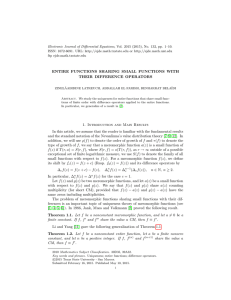
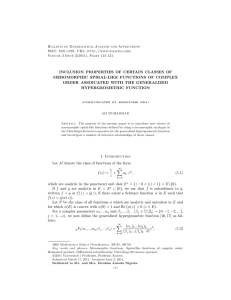
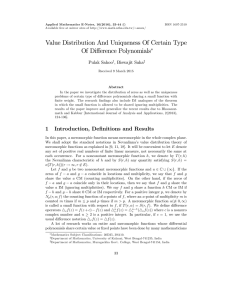
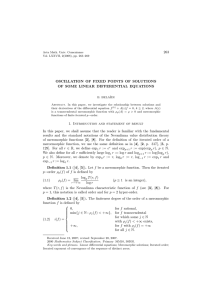
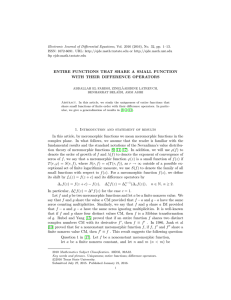

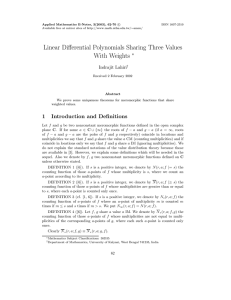

![5.5 The Haar basis is Unconditional in L [0, 1], 1 < 1](http://s2.studylib.net/store/data/010396305_1-450d5558097f626a0645448301e2bb4e-300x300.png)

